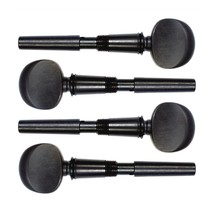Tuning Pegs
Showing 38 of 38 products
Ebonised Cello Peg, 4/4 Size

Ebonised Cello Peg, 3/4 Size

Ebonised Cello Peg, 1/2 Size

Ebonised Cello Peg, 1/4 Size

Ebony Violin Peg, 4/4 Size

Ebony Violin Peg, 3/4 Size

Ebony Violin Peg, 1/2 Size

Ebony Violin Peg, 1/4 Size

Ebony Violin Peg, 1/8 Size

Jujube Cello Peg, 4/4 Size

Jujube Cello Peg, 3/4 Size

Jujube Cello Peg, 1/2 Size

Jujube Cello Peg, 1/4 Size

Ebony Cello Peg, 4/4 Size

Ebony Cello Peg, 3/4 Size

Ebony Cello Peg, 1/2 Size

Ebony Cello Peg, 1/4 Size

Wittner Slim Violin FineTune Pegs, Pack of 4

Wittner Medium Violin FineTune Pegs, Pack of 4

Wittner Medium Cello FineTune Peg, Pack of 4

Wittner Slim Cello FineTune Pegs, Pack of 4

Wittner Medium Viola FineTune Pegs, Set of 4

Wittner Large Viola FineTune Pegs, Pack of 4

Wittner Medium Violin Rosewood FineTune Pegs, Pack of 4

Wittner Slim 1/2 Cello FineTune Pegs, Pack of 4

Perfection Peg Set Violin/Viola Plastic 4/4 8.5mm

Perfection Peg Set Violin/Viola Plastic 4/4 7.8mm

Perfection Peg Set Violin/Viola Plastic 3/4-1/2 7.8mm

Wittner 1/2 Cello FineTune Pegs, Pack of 4

Wittner Large Cello FineTune Pegs, Pack of 4

Perfection Peg 5 Peg Set Violin/Viola Plastic 8.5mm

Perfection Peg Set Violin/Viola Ebony Swiss 4/4 9.0mm

Perfection Peg Set Violin/Viola Ebony Swiss 4/4 8.5mm

Perfection Peg Set Violin Ebony Swiss 4/4 8.3mm

Perfection Peg Set Violin Ebony Swiss 4/4 7.8mm

Perfection Peg Set Violin/Viola Rosewood Swiss 4/4 9.0mm

Perfection Peg Set Violin/Viola Rosewood Swiss 4/4 8.3mm

Perfection 5 String Peg Set Violin Ebony Swiss 4/4 8.5mm

About Orchestral Tuning Pegs
Tuning pegs are essential for adjusting the pitch of string instruments like violins, violas, and cellos. They are inserted into the pegbox, and the strings are wound around them. When you turn the pegs, the tension of the strings changes, raising or lowering the pitch. Tuning pegs are made from various materials, including ebony, jujube wood, and high-tech composites. Traditional pegs made of wood are common, offering a balance of durability and smooth turning.
Newer composite pegs, like Wittner FineTune pegs, provide more precise control and stability, particularly useful in fluctuating climates. Selecting the right pegs for your instrument is vital for ease of tuning and maintaining the desired pitch. Regular maintenance, such as ensuring proper fit and applying peg compound like Conrad Goetz peg soap, can help prevent slippage and ensure consistent tuning performance.
FAQs
Are all violin pegs the same?
No, not all violin pegs are the same, although they do the same job violin pegs come in different sizes and styles to suit different violins. Violin pegs are also made out of a range of materials from ebony to composite offering a range of options for violinists.
Can you replace violin pegs?
Yes it is possible for violin pegs to be replaced however its recommended that you take the instrument to a violin repairer this will ensure any risk of damage is minimised and that the pegs are replaced properly.
How do you tune the pegs on a viola?<
Tuning the pegs on a viola follows the basis of all stringed instruments is fairly simple, just turn the peg to the right to tighten or sharpen the tone and turn the peg to the left to loosen or flatten the tone.

